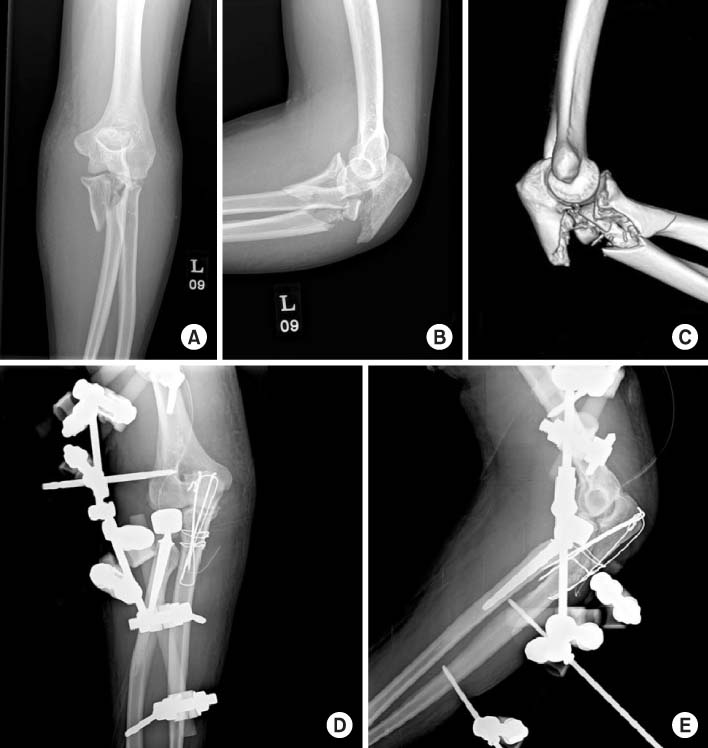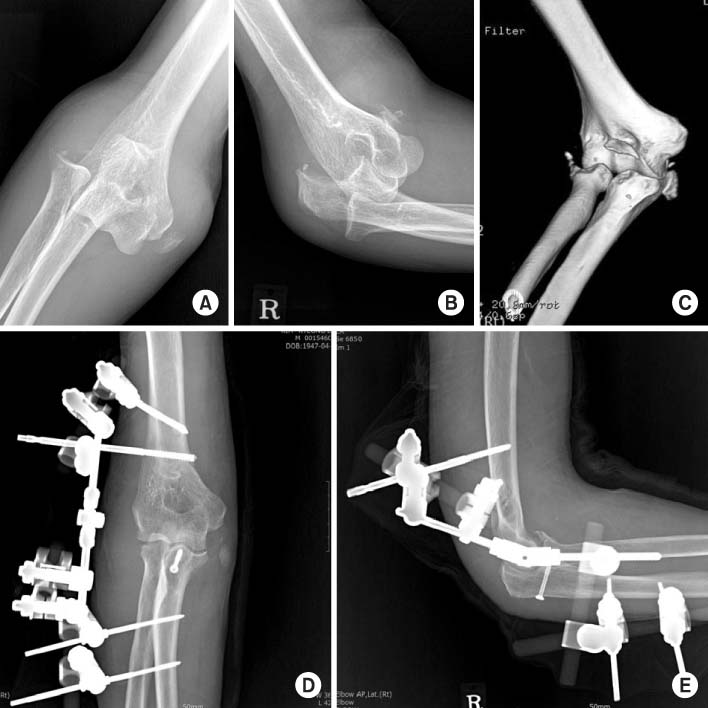J Korean Fract Soc.
2015 Jul;28(3):169-177. 10.12671/jkfs.2015.28.3.169.
Additional Hinged External Fixation in Complex Elbow Injury
- Affiliations
-
- 1Department of Orthopedic Surgery, Inha University School of Medicine, Incheon, Korea. TJLEE@inha.ac.kr
- KMID: 2184412
- DOI: http://doi.org/10.12671/jkfs.2015.28.3.169
Abstract
- PURPOSE
The purpose of this study was to evaluate the use of hinged external fixation in management of complex elbow injury.
MATERIALS AND METHODS
We retrospectively reviewed clinical outcomes in 10 patients with elbow dislocation and associated fractures of both the radial head and the coronoid process from January 2007 to December 2013. All ten patients were treated by hinged external fixation after open reduction and internal fixation. The indication for use of a hinged external fixator was persistent instability after fixation of the fractures. Early mobilization was started at 1 week (6.5 days) after surgery. The external fixator was removed at 6 weeks after surgery. Cassebaum classification and Mayo elbow performance score were used for clinical and functional evaluation. The follow-up period was at least 1 year.
RESULTS
At the last follow-up, the average further flexion was 127degrees, and the average flexion contracture was 16degrees. The average pronation was 83degrees and the average supination was 78degrees. By the Cassebaum classification after 1 year follow-up, patients were classified as 4 excellent, 4 good, and 2 poor. According to the Mayo elbow performance score, the average score was 87 points (65-100 points) with 3 excellent, 6 good, and 1 fair. Stability was restored in all patients at the last follow-up. There was no case of nonunion and the average union period was 11.5 weeks.
CONCLUSION
This study advocated the additional use of a hinged external fixator in the treatment of complex elbow instability, especially when fixation of fractures and repair of soft tissues were not sufficient. Providing adequate stability and allowing early motion, additional external fixation could improve the functional outcome.
Keyword
MeSH Terms
Figure
Reference
-
1. Josefsson PO, Gentz CF, Johnell O, Wendeberg B. Dislocations of the elbow and intraarticular fractures. Clin Orthop Relat Res. 1989; (246):126–130.
Article2. Ball CM, Galatz LM, Yamaguchi K. Elbow instability: treatment strategies and emerging concepts. Instr Course Lect. 2002; 51:53–61.3. Broberg MA, Morrey BF. Results of treatment of fracture-dislocations of the elbow. Clin Orthop Relat Res. 1987; (216):109–119.
Article4. Zilkens C, Graf M, Anastasiadis A, Smajic S, Muhr G, Kälicke T. Treatment of acute and chronic elbow instability with a hinged external fixator after fracture dislocation. Acta Orthop Belg. 2009; 75:167–174.5. McKee MD, Bowden SH, King GJ, et al. Management of recurrent, complex instability of the elbow with a hinged external fixator. J Bone Joint Surg Br. 1998; 80:1031–1036.
Article6. Pugh DM, Wild LM, Schemitsch EH, King GJ, McKee MD. Standard surgical protocol to treat elbow dislocations with radial head and coronoid fractures. J Bone Joint Surg Am. 2004; 86-A:1122–1130.
Article7. Papandrea RF, Morrey BF, O'Driscoll SW. Reconstruction for persistent instability of the elbow after coronoid fracture-dislocation. J Shoulder Elbow Surg. 2007; 16:68–77.
Article8. Ring D, Hannouche D, Jupiter JB. Surgical treatment of persistent dislocation or subluxation of the ulnohumeral joint after fracture-dislocation of the elbow. J Hand Surg Am. 2004; 29:470–480.
Article9. Kälicke T, Westhoff J, Wingenfeld C, Muhr G, Arens S. Fracture dislocation of the elbow involving the coronoid process. Unfallchirurg. 2003; 106:300–305.10. Berendes S, Zilkens C, Anastasiadis A, Graf M, Muhr G, Kalicke T. Additional external hinged fixator after open repositioning and internal fixation of acute elbow instability in non-compliant patients. Orthop Rev (Pavia). 2010; 2:e21.
Article11. Stavlas P, Gliatis J, Polyzois V, Polyzois D. Unilateral hinged external fixator of the elbow in complex elbow injuries. Injury. 2004; 35:1158–1166.
Article12. Rettig AC. Traumatic elbow injuries in the athlete. Orthop Clin North Am. 2002; 33:509–522.
Article13. Kim BS, Kim YB. Hinged elbow fixation for persistent instability following complex elbow fracture dislocation. J Korean Soc Surg Hand. 2007; 12:120–124.14. Madey SM, Bottlang M, Steyers CM, Marsh JL, Brown TD. Hinged external fixation of the elbow: optimal axis alignment to minimize motion resistance. J Orthop Trauma. 2000; 14:41–47.
Article15. King GJ, Zarzour ZD, Rath DA, Dunning CE, Patterson SD, Johnson JA. Metallic radial head arthroplasty improves valgus stability of the elbow. Clin Orthop Relat Res. 1999; (368):114–125.
Article16. Closkey RF, Goode JR, Kirschenbaum D, Cody RP. The role of the coronoid process in elbow stability. A biomechanical analysis of axial loading. J Bone Joint Surg Am. 2000; 82-A:1749–1753.17. Chemama B, Bonnevialle N, Peter O, Mansat P, Bonnevialle P. Terrible triad injury of the elbow: how to improve outcomes? Orthop Traumatol Surg Res. 2010; 96:147–154.
Article
- Full Text Links
- Actions
-
Cited
- CITED
-
- Close
- Share
- Similar articles
-
- Chronic Unreduced Elbow Dislocation Treated with Hinged External Fixator and Transarticular Pin Fixation
- Neglected Elbow Dislocation Occurred 3 Years Ago: Open Reduction and Hinged External Fixation: A Case Report
- Treatment of Periarticular Fracture of Elbow with Hinged External Fixator
- Surgical Treatment of the Fracture and Dislocation of the Elbow and Early Controlled Mobilization
- Biologic Arthroplasty of the Elbow Joint




